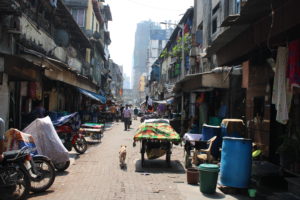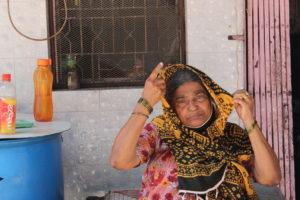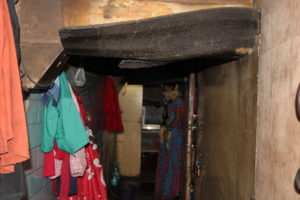With Coronavirus, no entry in Mumbai’s red light districts
Sex workers are amongst the most exploited and vulnerable communities in the country. The unplanned lockdown following coronavirus has made them even more so.
On a usual day, the 11th lane of Kamathipura, the infamous red-light neighbourhood in central Mumbai, is filled with men from all strata of society, looking for prostitutes. However, since the lockdown was announced on March 25, not just the 11th lane, but entire Kamathipura wears a forlorn look with the sex workers simply sitting outside their small houses, little better than a slum, waiting for the lockdown to end and their normal life to resume so they could earn money.
Fatima Maktoom, who has been living in the area for the past 55 years, says that she has never seen anything like this in her lifetime. “The situation is really terrible here. It’s more than 25 days that work here has stopped. We can eat only when someone gives us food. If someday no one gives, then we don’t eat. All these days, there has been no support from the government. The little rations being distributed by the municipality, for how long can it feed a family of 4-5 people? Families with 4-5 children don’t know how they are going to provide their kids with food the next day.”
Fatima, who hails from a small village in Bijapur district in the southern state of Karnataka, says that she would have preferred to go back to her village and be with her family when the lockdown was announced, but she could not leave as the government had stopped the trains.
Kamathipura, one of the oldest and best known red light districts of India, serves as home to nearly 4,500 sex workers of all ages and hailing from all over India as well as Nepal and Bangladesh. The established workers, who have been around for decades, now own the homes in which rooms are rented out to other workers on a regular basis or even per night as there are several women who come to Kamathipura to ply their trade every night and head back home the next morning.
Sangeeta, a slim woman in her forties, left her village in Bardhaman district of the eastern state of West Bengal, nearly 15 years ago and settled in Kamathipura where she began her life as a sex worker. A peep inside Sangeeta’s home gives a fair inkling of the condition and lives of the sex workers here. Most of the buildings are two-storeyed or four, each admeasuring barely 30sqm. On each floor there are four rooms and a common washroom. Sangeeta’s room is on the first floor of the dark and dingy building, which has a narrow corridor, barely 50 cm wide that leads from the main door to each room. The staircase is even narrower and rather tricky to navigate. Upstairs, Sangeeta opens the door to her room and one can see a small bed, just about wide enough to accommodate two persons, with pictures of deities on the wall and the only source of ventilation being a small fan hanging by the roof, barely a metre higher from the bed. With each building housing up to 30 persons, social distancing is a mere myth here.
Sangeeta says no one forced her to come to Kamathipura or into the profession that she got into voluntarily as the only way to support her family that still lives in the ancestral village. As if it were from a previous era, Sangeeta reminiscences of the happier days. “Everything was going well for us but this coronavirus has hit our business drastically. Earlier we could manage to earn INR 500-600 per day but now nothing. I have family in Bardhaman and I used to send them some money, but now even that is out of question,” she says.
Sangeeta says that even if food is provided by various charities or the government, she still needs some money as she is on a medication. “I am diabetic and I need money to buy medicines for that. They are giving food to us but I need INR 400 to buy medicine for 10 days. If I don’t get medicine then I will die,” she says plainly.
There are indeed other challenges for the sex workers in the area. A few of them are HIV+ and need their anti retroviral treatments regularly to survive. This work is essentially being done by the government in cooperation with numerous NGOs that work with not only commercial sex workers, but also transgenders and injectible drug users. Dr Srikala Acharya is the associate project director of Mumbai District AIDS Control Society, the government body charged with controlling the spread of HIV as well as ensuring that the patients receive their medication in a timely manner.
“So far, the lockdown has not had any real impact in terms of our work as we are ensuring that the patients get their ARTs on time. Also, to make things simpler, we have asked the doctors to give the dose for two months, instead of every month, in order to minimise the risk of any person not being able to reach our clinics to receive their ARTs,” she says.
However, Acharya acknowledges that field screening activity has come to a screeching halt in order to keep the social distancing norms in place currently. But she is not unduly worried about the impact of this on HIV prevalence in the area. “The proportion of HIV+ persons within the commercial sex workers is very low. In all, we are catering to about 380 persons including all categories. Hence, I don’t foresee a sharp rise in risk of HIV infections if we are not able to carry out field screenings for a few weeks,” says Dr Acharya.
Amongst the handful of charities assisting the sex workers and other residents of Kamathipura, is the local Ganesh Utsav Mandal, the local group that organises the Ganesh festival each year, the biggest festival in Maharashtra. The organisation has been trying to help the residents of the area ever since the lockdown was announced, says Mohammad Salim, a member of the Mandal. He criticises the government for its failure in helping people. “In groceries, the government is only providing for food grains but is not giving them spices that are essential cooking ingredients. They are not even providing kerosene as many here don’t have cooking gas and they are forced to buy the fuel which now costs INR 80 per litre. How are they going to do that? We have also been trying to arrange some money for them so that they can buy these essential items. So far, we have not received any help from the government,” he says.
Salim is not the only one who thinks that the government can and ought to do more to help the poor who have been deeply impacted by the sudden lockdown. “We need so many things to be able to survive this lockdown as we cannot go back to our villages. The government has so much money, why is it not giving it to the poor and the needy. This is the time when we need the help,’’ appeals Makhtoom, the grand old lady of the 11th lane. Alas, it is quite a distance from the 11th lane of Kamathipura in Mumbai to 7 Race Course Road in New Delhi.













